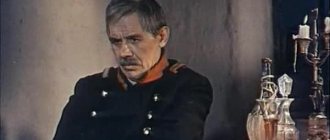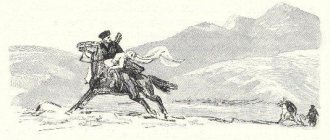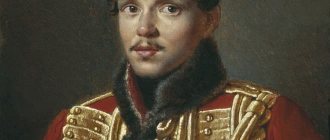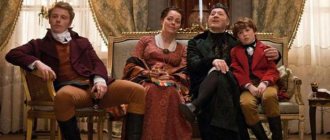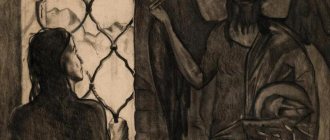- Essays
- On literature
- Lermontov
- Water society in the novel A Hero of Our Time
Water society in the novel by M.Yu. Lermontov’s “Hero of Our Time” is represented by the nobility who are undergoing treatment and prefer to relax in the Caucasian mineral resorts. Among the people classified as a privileged class, you can meet both visitors and local residents. The lifestyle of the nobles is described in the chapter “Princess Mary”. The main character, Pechorin, opposes himself to all representatives of the water society, because he does not consider himself one of them.
It is no coincidence that the nobility appears in the novel. Thanks to the class, the author reveals the problem of personality, its relationship with the outside world - one of the most important lines in Lermontov’s work. The Water Society helps to fully display the image of Grigory Pechorin. The community was formed in the vast Kislovodsk healing springs and includes representatives of the upper class - nobles, landowners and dandies.
The provincial elite pursues the only goal - it is more profitable to marry off their daughters. What can be immediately noticed by the outfits of the ladies - brilliant and expensive, and the fathers and brothers - in shabby frock coats and suits. The arriving young officer Grigory is initially mistaken for a resident of the capital, but after he puts on his uniform, all interest in him disappears.
Young people looking for romantic adventures are not so picky. Ladies know that among officers you can often meet a smart and thoughtful person, under whose uniform a heart that is ardent and thirsty for love will beat.
Single men vacationing at the resort - both military and civilian - are considered dandies. They express boredom in their appearance and prefer sparkling wines to mineral waters. Representatives of the stronger sex are lazy and treat everything that happens with indifference; they even look after their companions without much zeal.
Among the representatives of the water society, Princess Mary stands out. The girl is distinguished by her beauty, erudition and education. Kindness, compassion, naivety and inexperience pushes Mary to intrigue, leading to the sophisticated Pechorin.
The water society that has developed in the vast Caucasus can be compared to a provincial demimonde, resembling the capital's aristocrats. Laziness, idleness and envy reign here. Grigory Aleksandrovich is higher in intellectual development, fully aware of the degree of emptiness and worthlessness of the water society, but for some time he still becomes part of it.
Essay 3
The novel “A Hero of Our Time” is one of the greatest works of Russian literature. The novel reveals not only the inner world, the soul of the hero, but also the society around him.
In the story “Princess Mary” Grigory Pechorin, the main character of the work, is opposed to the water society. “Water Society” is a satirical collective image of all the people who come to the waters. The water society includes people of noble origin - nobles. Lermontov put into this collective image all the features characteristic of his era; this image personifies the entire secular society in the 19th century.
In the very first days of his stay on the waters, Pechorin notices that the people here are unpleasant: they love gossip, secretly envy and despise each other. During his first acquaintance with the society of Pyatigorsk, Pechorin immediately understands its entire essence: seeing army epaulettes, a small group of people turned away from the hero with disgust, and from an overheard conversation Grigory learns that the only thing military people dream about here are capital hotels. All this pushes away the main character, because he is completely different.
At the mineral waters, Pechorin meets with his old friend Grushnitsky. The hero treats Grushnitsky with ridicule, because he is only trying to show himself, to make sure he is remembered. It seems that this hero is purely sincere, but in fact his feelings are false.
The entire water society seems to be divided into several classes.
The first class are provincial nobles. They came to the waters not to improve their health, but to find grooms for their daughters. Their main goal is to successfully marry their daughters, so they pay close attention to all visitors.
The second class is the dandies. These are people who are always dissatisfied with something, they look at provincial society with contempt, and dream of returning to the capital. The dandies are constantly drinking and spreading gossip.
The third class is water youth. These are young nobles and officers. They lead a Soviet measured life, attend balls and court ladies.
Women should be included in a separate class. The women here are the wives and daughters of provincial nobles. Their activities are the dissolution of gossip and intrigue, eternal flirting and short novels. Pechorin notices that the ladies here are dressed very elegantly, unlike their husbands and fathers.
One of the positive characters is Princess Mary. The water society has not yet had time to touch her pure soul, to leave its dark mark on her character and morals.
Thus, the water society denounces the nobility and aristocracy of the 19th century. Lermontov shows all the spiritual emptiness of this society, the love of gossip and intrigue, hypocrisy, pretense. Representatives of this society lead a calm and measured life, they have no meaning in life, no moral values, they are simply inactive.
“Water Society” in Lermontov’s novel “Hero of Our Time”
«Hero of our time
"is a novel in which socio-psychological problems are clearly revealed. In the content of the novel, the author tries with all his might to convey and describe the inner world of the main character, who was the image of the young generation of those times. M.Yu. Lermontov creates different life scenes and episodes in which he shows the conflict between the main character and the society around him. In one of the stories of the novel “Princess Mary”, Pechorin’s personality is directly opposed to the participants in the water society. What kind of society is this? This is a circle of people - local and metropolitan nobility, who convey the main character traits and behavior of people of that era. What dominates in such a society is hypocrisy, feigned emotions, feelings of envy of each other, petty affairs and dirty gossip. The “water society” is compared to a secular circle of people.
Spending time in such a society, Pechorin
opposes almost all of its members.
But there are also similar images. For example, Grushnitsky
can be classified as a parody character who tried to imitate Pechorin in everything. He tried to feign feelings of joy and happiness, although in reality he felt neither one nor the other. He tries to create a romantic relationship, but as soon as he gets into it, he is immediately lost. He tries to impress others, and it reaches the point of caricature. Grushnitsky's act in the duel is low and vile. He deprives him of his masculine nobility and honor. His pride overshadows all other emotions.
The image of Werner can be compared with the image of Pechorin. They are both witty, they both have the same views on society. But the inner world of the protagonist rushes forward to meet life. And Werner’s insides are filled with calm and passivity.
Several bright female images were created by the author in order to reveal the character of the main character as deeply as possible. Description of Princess Mary
the most detailed. The relationship with the princess prompts Pechorin to create deep diary entries in which he writes about their conversations, in which the hero shares his attitude towards others.
Image of Vera
given incompletely. But it is precisely the relationship with this woman that shows the reader the true fact that Pechorin did not know how to truly love and did not understand the feelings of female love at all.
After Grigory Alexandrovich’s arrival in Pyatigorsk, we can get acquainted with the description of family relationships of that time. A separate class consists of civilian and military men. Particularly passionate speech is made about the youth of the “water society”. It tells about their unknown passion for evening balls, for celebrations at which dirty gossip is constantly being waged. This provincial society was so much like a secular gathering of the same hypocritical and empty people.
Therefore, the topic of “water society” was not in vain touched upon by M.Yu. Lermontov. He tried to reveal and show the essence of the relationship between an individual and an entire society of that time and era.
Did you like your school essay? And here's another:
The image of Vera in Lermontov’s novel “Hero of Our Time” Female images in the novel “Hero of Our Time” Bel and Mary (based on Lermontov’s novel “Hero of Our Time”) Love in the life of Pechorin (based on Lermontov’s novel “Hero of Our Time”)
Water Society
The main character of the novel “A Hero of Our Time,” Grigory Pechorin, belongs to the category of “superfluous people.” Lermontov very succinctly fits a young man into different life situations; he creates a clash between a narcissistic egoist and people of different character and principles of life. The author very skillfully parallels his character with the environment.
“Water Society” are people opposed to Pechorin. But in the novel we can also meet characters similar in worldview to the main character. For example, the image of Grushnitsky is presented in the novel as a caricature of Pechorin, the image of the cadet is characterized by a spectacular pose, it was thanks to it that he believed that he could impress young ladies. Often, he convinces others of non-existent information, and his characteristic feature is behavior inappropriate to the circumstances. So, we can remember his participation in the duel, how ignoble and base he acted, his enormous ambitions did not allow him to retreat.
In the work we see Pechorin’s opposition to the “water society” and life in general. In this novel, “water society” is a collective image. It includes representatives of the noble family, their behavior and lifestyle are typical of that time.
The novel clearly presents the conflict between the individual and society; this confrontation is depicted to reveal the character of the main character, Pechorin, and the possibility of reflecting his priorities for life in the “water society.” On the pages of the work, we see how the main character tries to hide with his disdain his envy of the intelligentsia and their love of plotting and slandering. The novel also shows the morals of society; they were determined by historical events.
There is 1 character in the work that can be compared with the main character - Werner. Their similarities can be found in their mental acuity, relationships with people and skepticism. Only, unlike Pechorin, Werner is not very complex and deep, and is also very active.
Female images in the work help to reveal Pechorin's views on love. Mary and Vera. The first is depicted in the novel as a very romantic, witty, young and not stupid girl, only a little naive, but at the same time pure; this image clearly shows Pechorin’s selfishness. Thus, the author does not describe the second representative of the fair sex in the novel very clearly, but still compares her with Pechorin, we see all his tragic situation and inability to truly love.
M. Yu. Lermontov set his main task to reveal a complex personality, for this he showed her interaction with the outside world. That is why the “Water Society” was not accidentally introduced by the author into the novel.
Essay: Water society in the novel “Hero of Our Time” (M.Yu. Lermontov)
(455 words) M. Yu. Lermontov’s novel “A Hero of Our Time” consists of several stories, each of which is a sketch of the society of that time. Thus, the work “Princess Mary” introduces us to vacationers “on the waters” in Pyatigorsk. These are mainly nobles - local and those arriving from the capital. Their behavior reflects the traditions, life and customs of the era described in the story. Pechorin and the “water society” constantly find themselves on opposite sides of the barricades. But do they have similar features? How did Lermontov see his contemporaries through the eyes of the protagonist?
It seems that Pechorin is contemptuous of vacationers. He notices that they envy each other, spread rumors, and weave intrigues. This is how it has developed over many years of relationships between representatives of different strata. People “on the waters” seem to distance themselves from secular society. But they are already so accustomed to behaving commeilfaut that they cannot instantly transform themselves. And it’s unlikely that the nobles want changes. Some heroes, however, stand out from others. So, Grushnitsky in the story is like a parody of Pechorin. The hero is very proud, romantic, and impractical. His tendency to build castles in the air reaches the point of absurdity, to the point of recklessness, and this is also why he decides to participate in a duel. This is a clear antipode of Pechorin, constantly looking for and craving romance in everyday situations, but unable to express himself.
The image of Werner in the work is not opposed to the image of the main character, but is compared with him. Young people have almost the same attitude towards others, they show skepticism and wit. But Pechorin, as they say in the novel, is “chasing life.” Werner can rather be called passive, somewhat apathetic. Even on the eve of the duel, Pechorin thinks tenderly about the beauty of nature, and Werner thinks about money issues. How often do we meet such people not only “on the waters”, but also in everyday life!
But Princess Mary is a rarer “copy” in the line of society ladies. She is very young, intelligent, ironic, but naive and pure. Compared to her, Pechorin looks like a real egoist. The relationship with Princess Mary becomes an occasion for the hero to analyze his own behavior and enter into dialogue with himself. But does he love the young woman? Hardly. For him, she is one of many representatives of the “water society”: smart and serious, but subject to influence. Another thing is Faith. Her image is presented schematically by the author. Pechorin feels such loneliness and such detachment that even his once only beloved becomes no longer needed. The hero whiles away his time in conversations with steppe landowners, who are arrogant and condescending towards the military, and meetings with “mistresses of the waters”, who are looking for a sharp mind and ardent hearts in men.
And in the water society there are “water youth”. Young men, just like their predecessors, long to receive the next rank, bow to famous military men and high-society rich people, and dance with ladies at balls. This is all the same metropolitan society. However, is it metropolitan? Rather provincial, dreaming of “reaching” the capital, to resemble true nobles as much as possible. Therefore, both the author and his hero treat what is happening with irony, and we, the readers, get the opportunity to reflect on the problems of the relationship between the individual and society.
Author: Victoria Harutyunyan
